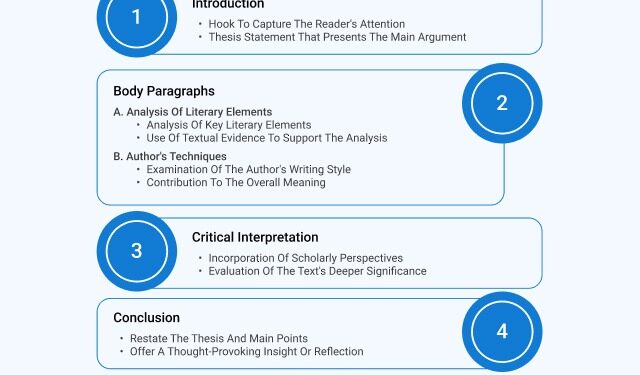Introduction
How To Write A Literary Analysis Essay One of the most important skills for students studying literature is writing a literary analysis essay.
A literary analysis essay enables you to examine the text’s themes, characters, literary devices, and deeper meanings, regardless of whether you’re studying a play, novel, short story, or poetry.
An in-depth analysis of the text and a perceptive interpretation that goes beyond a narrative synopsis are necessary for this kind of essay.
1. Prewriting: Understanding the Text and Planning
Before you even begin writing your literary analysis essay, it’s essential to thoroughly understand the text you are analyzing. Prewriting is a crucial step that allows you to gather your thoughts, organize your ideas, and determine the direction your essay will take.
Read the Text Carefully
The first step is to read the literary work closely. Take notes as you read, and pay attention to key elements such as characters, themes, symbols, tone, setting, and literary devices like imagery, metaphors, and motifs. It’s also helpful to annotate the text by underlining or highlighting significant passages and writing marginal notes. This will make it easier to reference specific quotes in your analysis later on.
Identify Key Themes
As you read, try to identify the central themes of the work. What is the author trying to convey through the story? Themes may include concepts like love, loss, identity, social justice, or morality. Understanding the core themes will provide the foundation for your thesis statement and help guide the focus of your analysis.
Consider the Author’s Purpose and Context
Reflect on the author’s background, historical context, and the literary period in which the work was written. Does the author’s life experience influence the story? Is the work a response to social, political, or cultural issues? Understanding the context can deepen your interpretation and add richness to your analysis.
Research Literary Criticism
It can also be useful to read other scholarly articles or literary criticism related to the work you are analyzing. Literary critics often provide different perspectives on themes, symbols, or character motivations, which can help you develop your own analysis. Just be sure not to rely solely on secondary sources—your primary focus should remain on the text itself.

2. Developing a Strong Thesis Statement
The thesis statement is the most important part of your literary analysis essay. It provides a concise summary of the argument you intend to make and serves as a guide for the entire essay. Without a clear thesis, your essay may lack direction and coherence.
What is a Thesis Statement?
A thesis statement is a one- or two-sentence summary of your main point or argument about the text. It should address a specific aspect of the text and offer a meaningful interpretation. The thesis should not simply summarize the plot, but rather analyze the underlying meaning or significance of the text.
Crafting a Strong Thesis
To develop a strong thesis statement, consider the following questions:
- What is the main theme or idea of the text?
- How do the author’s choices (language, style, structure, etc.) contribute to the meaning of the work?
- What is the significance of key symbols, characters, or events in the text?
Your thesis should present a clear argument and be specific enough to be supported by examples from the text. Avoid making overly broad or vague statements. Instead, focus on a particular element of the text that you can analyze in depth.
For example, a weak thesis might be:
- “In this novel, the author discusses the importance of friendship.”
A stronger thesis might be:
- “Through the evolving friendship between the protagonist and his mentor, the author explores the idea of personal growth and the transformative power of relationships.”
Refining Your Thesis
As you proceed with your analysis, you may find that your thesis evolves. That’s okay! Your thesis should remain flexible and adaptable as you gather evidence and refine your argument. The goal is to ensure that your thesis reflects a thoughtful and complex interpretation of the text.
Read More :
3. Organizing the Essay Structure
Once you have a clear thesis statement, it’s time to structure your literary analysis essay. A well-organized essay helps the reader follow your argument and supports the clarity of your analysis.
Introduction
The introduction serves as a roadmap for your essay. It should provide some background information on the text, introduce your thesis statement, and establish the significance of your argument. Start with a hook to grab the reader’s attention—this could be a thought-provoking question, a relevant quote, or an interesting observation about the text.
A typical introduction might look like this:
- Hook: “In a world defined by superficiality and false appearances, how do we distinguish between what is real and what is not?”
- Context: “In F. Scott Fitzgerald’s The Great Gatsby, the narrator Nick Carraway grapples with the blurred lines between illusion and reality as he navigates the excesses of the Jazz Age.”
- Thesis Statement: “Through the use of symbolism, character development, and narrative voice, Fitzgerald reveals the inherent contradictions within the American Dream, ultimately illustrating its hollowness.”
Body Paragraphs
The body of the essay is where you will present your analysis and support your thesis. Each paragraph should focus on a single point or argument related to your thesis and provide evidence from the text to back up your claims.
A well-organized body paragraph typically follows this structure:
- Topic Sentence: A clear statement that introduces the main idea of the paragraph.
- Evidence/Examples: Specific quotes, passages, or scenes from the text that support your argument.
- Analysis: Your interpretation of the evidence and how it connects to your thesis.
- Conclusion/Transition: A brief summary of the paragraph’s main point and a transition to the next idea.
For example, if you are analyzing the symbolism of the green light in The Great Gatsby, one paragraph might look like this:
- Topic Sentence: “The green light at the end of Daisy’s dock symbolizes Gatsby’s unattainable dreams and his obsessive pursuit of an idealized past.”
- Evidence/Example: “In Chapter 5, Gatsby reaches out towards the light, desperate to reclaim what he believes is his destiny, despite the passage of time and the impossibility of turning back.”
- Analysis: “The green light represents Gatsby’s futile attempt to recreate an idealized version of the past, reinforcing the theme of disillusionment with the American Dream.”
- Conclusion/Transition: “Ultimately, the green light symbolizes the unattainable nature of Gatsby’s aspirations, which echoes the broader critique of materialism and social ambition in the novel.”
Conclusion
The conclusion is the final paragraph of your essay, where you summarize your main points and restate your thesis in a new light. The goal is not to introduce new ideas but to leave a lasting impression on the reader.
Begin by briefly revisiting your thesis and main arguments:
- “In conclusion, Fitzgerald’s use of symbolism in The Great Gatsby reveals the inherent contradictions of the American Dream and the tragedy of striving for an unattainable ideal.”
Then, consider broader implications or the significance of your analysis:
- “By examining the green light and other symbols, we gain a deeper understanding of the disillusionment that defines Gatsby’s life and the broader societal critique embedded in the novel.”
Finally, you may want to end with a thought-provoking statement that ties back to the text’s relevance or invites further reflection.
- “The green light, much like the American Dream itself, may forever remain a symbol of hope—and ultimately, a reminder of the illusion that sustains it.”
4. Writing the Body of the Essay
Writing the body of your literary analysis essay is where the majority of your critical thinking and analysis will take place. This is the part of the essay where you will engage deeply with the text, making connections between specific examples and the overall themes of the work.
Developing Strong Analysis
Each body paragraph should contain a combination of textual evidence and thoughtful analysis. The key is not just to summarize what happens in the story but to explain the significance of the events, characters, or symbols you are discussing.
For example, instead of simply noting that a character changes throughout the story, analyze why that change is significant to the overall message of the work. How does the character’s development reflect larger themes? What does it say about the human condition?
Using Quotes Effectively
When incorporating quotes from the text, make sure they are relevant and succinct. Avoid overloading your essay with long quotes. Instead, use brief excerpts that support your analysis, and be sure to explain their meaning and relevance.
Here’s an example of how to effectively use a quote:
- “Gatsby’s unwavering belief in the possibility of reclaiming the past is evident when he tells Nick, ‘Can’t repeat the past? Why of course you can!’ (Fitzgerald 110). This statement illustrates Gatsby’s refusal to acknowledge the passage of time, reinforcing the novel’s critique of blind ambition.”
Linking Back to the Thesis
Always make sure that each body paragraph connects back to your thesis statement. After providing evidence and analysis, explain how it supports the larger argument you are making about the text. This will help your essay stay focused and cohesive.
5. Revising and Proofreading
The final step in writing a literary analysis essay is revising and proofreading. This is where you refine your argument, clarify your ideas, and ensure that your essay is free of errors.
Revising for Clarity and Focus
After writing your initial draft, take a step back and evaluate the clarity and flow of your essay. Does your thesis still hold up? Are your arguments coherent and well-supported? Are your body paragraphs logically structured? During revision, focus on improving the organization of your ideas and ensuring that your argument is fully developed.
Proofreading for Grammar and Style
Once the content is solid, proofread your essay for grammar, spelling, punctuation, and formatting errors. Pay attention to sentence structure and word choice to ensure your writing is clear and concise. Additionally, check your citations to make sure they follow the appropriate style guide (MLA, APA, Chicago, etc.).
Reading Aloud
A helpful strategy is to read your essay aloud. This can help you catch awkward phrasing, unclear transitions, or repetitive language that may have gone unnoticed during writing.
![Proofreading and revising: what's the difference? [Updated 2024] - BibGuru Blog](https://www.bibguru.com/blog/img/proofreading-vs-revising-1400x696.png)
Conclusion
Although writing a literary analysis essay might first seem like a difficult undertaking, you can create a coherent and perceptive essay by adhering to these five steps: prewriting, thesis development, essay organization, body writing, and revision. You will improve your ability to evaluate books, decipher themes, and formulate strong arguments with practice. Keep in mind that writing a literary analysis essay involves more than just describing a work; it also entails critically and meaningfully interacting with it.
You can approach any literary work with confidence and write an essay that shows your comprehension of the text and your capacity for critical thought by segmenting the process into manageable steps. By following these guidelines, you’ll be well on your way to producing essays that are interesting, perceptive, and academically solid.
















